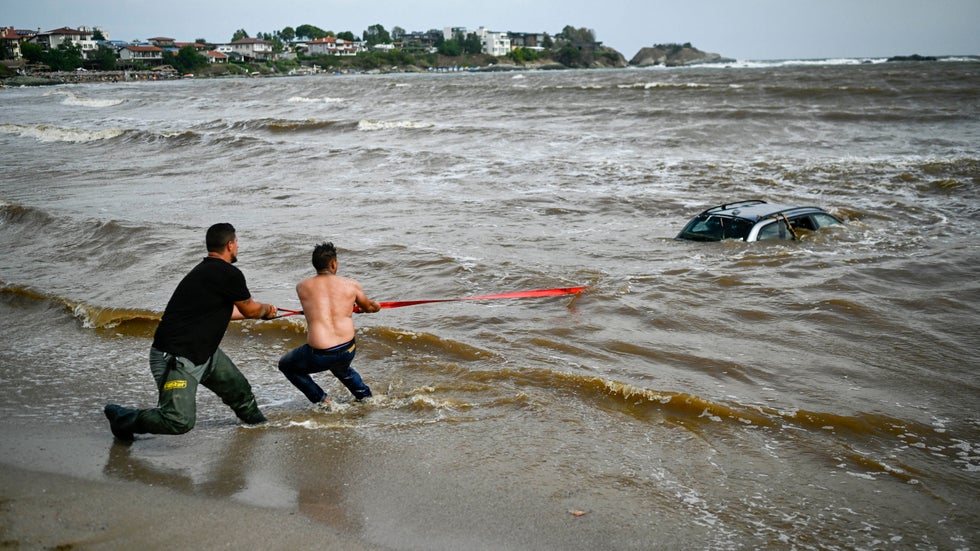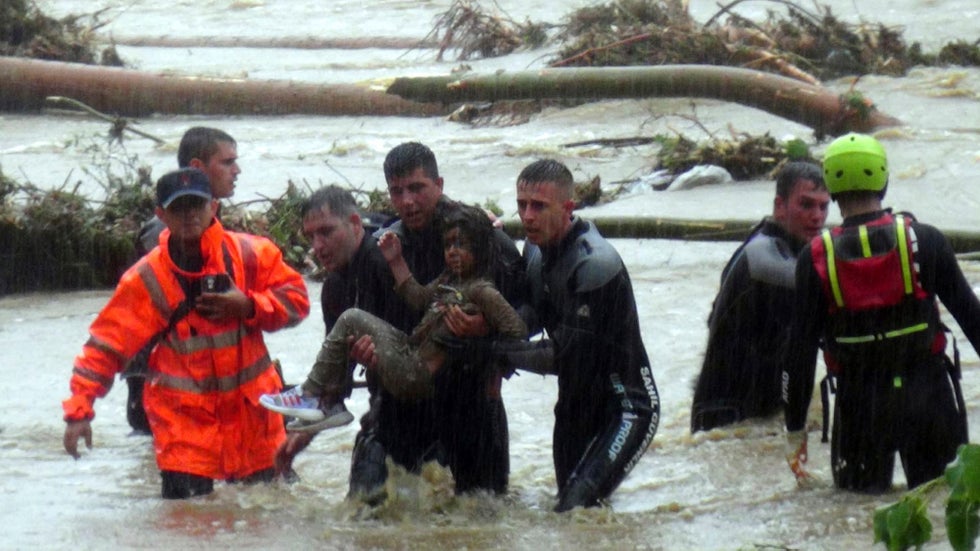Jan Wesner Childs
Torrential rainfall sweeping across parts of Europe has left at least at least 21 people dead and sent searchers desperately digging through mud and debris to try and find several others who were missing.
Among the hardest-hit countries are Spain and Greece, where floodwaters washed out roads and bridges and emergency services fielded thousands of calls for help.
Here's what we know:
-More than 2,500 people have been rescued from flooding in Greece this week. Ten deaths had been confirmed in the country and at least four people were still missing as of Friday.
-A 10-year-old boy was rescued in Spain after clinging to a tree for eight hours when his family's car was swept up in floodwaters, according to several media reports and the city of Madrid's emergency agency. The boy's sister and mother were found separately, but his father remained missing.
-Helicopters were deployed to Spain's Toledo region, southwest of Madrid, to pull people from the roofs of flooded homes. Up to 7 inches of rain fell in some parts of the country.
-According to the Coast Guard, 270 people were lifted to safety on Thursday and Friday as rescues continued.
-People in the city of Volos, Greece, ignored orders not to drive, to the point that the city's mayor walked through flooded streets to plead with motorists to go home.
-According to weather historian Chris Burt, it appears Greece shattered its all-time 24-hour rain record (29.69 inches at Zagora), in just an 18-hour period of extremely intense rainfall. Exact totals weren't immediately available.
 Floodwaters cover houses and farms after the country's record rainstorm in the village of Kastro, near Larissa, Thessaly region, central Greece, Thursday, Sept. 7, 2023.
Floodwaters cover houses and farms after the country's record rainstorm in the village of Kastro, near Larissa, Thessaly region, central Greece, Thursday, Sept. 7, 2023.Weather.com digital meteorologist Jonathan Belles adds:
-The flooding in Greece and the flooding in Spain are actually related by a pattern called an omega block. The pattern looks like the Greek letter Ω and features two low-pressure areas surrounding a ridge or dome of high pressure. This pattern is often a slow pattern to break up and can cause the atmosphere to remain stagnant for a week or two. You can think of this pattern as atmospheric constipation.
-At the ends of this blocked pattern, in this case, were two low-pressure systems over the Iberian peninsula and over the Balkans. The system over Greece has been formally named Storm Daniel by weather service offices in the region, but may also evolve into what is informally known as a "medicane," which is a subtropical storm with strong winds that often develop in the Mediterranean in the autumn months. They tend to cause issues for Greece, Italy, Malta and sometimes the northern coast of Africa.
-Each storm should begin to weaken by this weekend and the pattern could fall apart next week.
 People try to pull out a car submerged in the sea at Arapia camping site near Tsarevo along the Bulgarian Black sea coast on Wednesday, Sept. 6, 2023.
People try to pull out a car submerged in the sea at Arapia camping site near Tsarevo along the Bulgarian Black sea coast on Wednesday, Sept. 6, 2023.What else is happening:
-At least seven deaths are being reported from flooding in Turkey and four in Bulgaria.
-Wildfires have killed at least 20 people in Greece so far this year. Some of those blazes are still burning.
-Scientists say extreme rainfall events are happening more often due to climate change. A warmer atmosphere can hold more water, which can increase already heavy rainfall and flooding.
 Emergency team members rescue a young girl during floods in a campsite in Kirklareli province, Turkey, Tuesday, Sept. 5, 2023.
Emergency team members rescue a young girl during floods in a campsite in Kirklareli province, Turkey, Tuesday, Sept. 5, 2023.MORE ON WEATHER.COM
-Photos Show Major Flooding in Greece, Turkey, Bulgaria and Spain
-Satellites Show Global Warming Is Causing Intense Drought And Rain Events, Study Says
-Did Climate Change Play A Role In Fort Lauderdale Flooding?
-Here's How A Warmer World Could Affect Hurricane Season
-Why Aren't All Beach Houses Built On Stilts?
Information from The Associated Press was used in this report.
Weather.com reporter Jan Childs covers breaking news and features related to weather, space, climate change, the environment and everything in between.
The Weather Company’s primary journalistic mission is to report on breaking weather news, the environment and the importance of science to our lives. This story does not necessarily represent the position of our parent company, IBM.
The Weather Company’s primary journalistic mission is to report on breaking weather news, the environment and the importance of science to our lives. This story does not necessarily represent the position of our parent company, IBM.

No comments:
Post a Comment